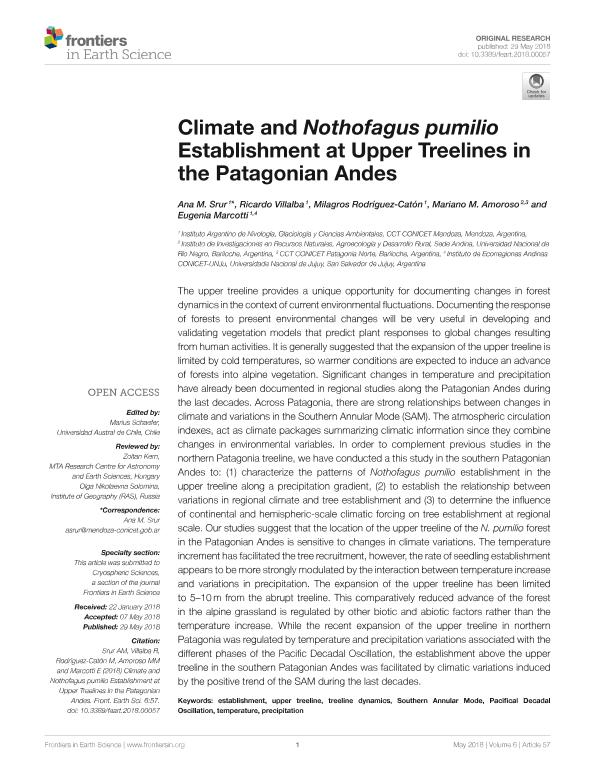Artículo
Climate and Nothofagus pumilio establishment at upper treelines in the patagonian andes
Srur, Ana Marina ; Villalba, Ricardo
; Villalba, Ricardo ; Rodriguez Catón, Milagros Rocío
; Rodriguez Catón, Milagros Rocío ; Amoroso, Mariano Martin
; Amoroso, Mariano Martin ; Marcotti, Eugenia
; Marcotti, Eugenia
 ; Villalba, Ricardo
; Villalba, Ricardo ; Rodriguez Catón, Milagros Rocío
; Rodriguez Catón, Milagros Rocío ; Amoroso, Mariano Martin
; Amoroso, Mariano Martin ; Marcotti, Eugenia
; Marcotti, Eugenia
Fecha de publicación:
29/05/2018
Editorial:
Frontiers Media SA
Revista:
Frontiers in Earth Science
ISSN:
2095-0195
e-ISSN:
2296-6463
Idioma:
Inglés
Tipo de recurso:
Artículo publicado
Clasificación temática:
Resumen
The upper treeline provides a unique opportunity for documenting changes in forest dynamics in the context of current environmental fluctuations. Documenting the response of forests to present environmental changes will be very useful in developing and validating vegetation models that predict plant responses to global changes resulting fromhuman activities. It is generally suggested that the expansion of the upper treeline is limited by cold temperatures, so warmer conditions are expected to induce an advance of forests into alpine vegetation. Significant changes in temperature and precipitation have already been documented in regional studies along the Patagonian Andes during the last decades. Across Patagonia, there are strong relationships between changes in climate and variations in the Southern Annular Mode (SAM). The atmospheric circulation indexes, act as climate packages summarizing climatic information since they combine changes in environmental variables. In order to complement previous studies in the northern Patagonia treeline, we have conducted a this study in the southern Patagonian Andes to: (1) characterize the patterns of Nothofagus pumilio establishment in the upper treeline along a precipitation gradient, (2) to establish the relationship between variations in regional climate and tree establishment and (3) to determine the influence of continental and hemispheric-scale climatic forcing on tree establishment at regional scale. Our studies suggest that the location of the upper treeline of the N. pumilio forest in the Patagonian Andes is sensitive to changes in climate variations. The temperature increment has facilitated the tree recruitment, however, the rate of seedling establishment appears to be more strongly modulated by the interaction between temperature increase and variations in precipitation. The expansion of the upper treeline has been limited to 5–10m from the abrupt treeline. This comparatively reduced advance of the forest in the alpine grassland is regulated by other biotic and abiotic factors rather than the temperature increase. While the recent expansion of the upper treeline in northern Patagonia was regulated by temperature and precipitation variations associated with the different phases of the Pacific Decadal Oscillation, the establishment above the upper treeline in the southern Patagonian Andes was facilitated by climatic variations induced by the positive trend of the SAM during the last decades.
Archivos asociados
Licencia
Identificadores
Colecciones
Articulos(CCT - PATAGONIA NORTE)
Articulos de CTRO.CIENTIFICO TECNOL.CONICET - PATAGONIA NORTE
Articulos de CTRO.CIENTIFICO TECNOL.CONICET - PATAGONIA NORTE
Articulos(IANIGLA)
Articulos de INST. ARG. DE NIVOLOGIA, GLACIOLOGIA Y CS. AMBIENT
Articulos de INST. ARG. DE NIVOLOGIA, GLACIOLOGIA Y CS. AMBIENT
Articulos(INECOA)
Articulos de INSTITUTO DE ECORREGIONES ANDINAS
Articulos de INSTITUTO DE ECORREGIONES ANDINAS
Citación
Srur, Ana Marina; Villalba, Ricardo; Rodriguez Catón, Milagros Rocío; Amoroso, Mariano Martin; Marcotti, Eugenia; Climate and Nothofagus pumilio establishment at upper treelines in the patagonian andes; Frontiers Media SA; Frontiers in Earth Science; 6; 29-5-2018; 1-11
Compartir
Altmétricas



